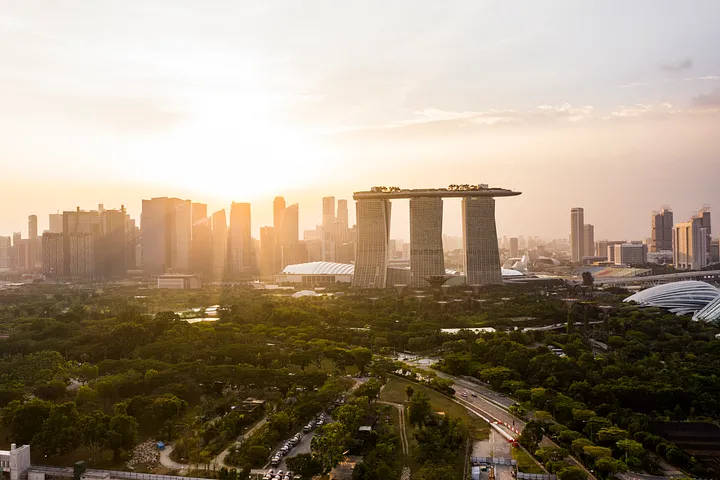
Photo by Kirill Petropavlov on Unsplash
What is worth learning from the Lion island nation is, first of all, the strategic vision of development and the solution to turn that vision into reality.
The goal is to continuously improve people’s quality of life
From the perspective of urban development, Singapore is considered to have a very good level of urban planning and management. With an area only slightly larger than Vietnam’s Phu Quoc island, a population of 5.3 million people, most of the houses are high-rise apartment buildings… it is clear that Singapore is a case of “compression” of buildings on a narrow area.
However, this country is recognized as the world’s leading Green — Clean — Beautiful, and livable country. Explaining this, a Western scholar in a book about Eastern countries admired: “Singapore is meticulous to every centimeter”. As a person who has been to Singapore many times, the writer of this article understands that, especially about the spatial organization and urban life of this island nation.
From “Garden in a City” to “City in a Garden”
In order to fit a sizeable population in a land-scarce city, right from the early days of the founding of the country, Singapore’s urban planning has prioritized green space and apartment development in order to save land space.
So today, despite changing the development strategy from “Garden in a City” to a greener, more civilized level “City in a Garden”, more than 90% of Singapore’s population is still content to live in high-rise apartments, fully equipped with modern facilities, of which 84% of houses belong to the Housing Development Board.
However, the quality of these “state apartments” whether they are nearly 40 years old or newly built is very good. Here, of course, there is a beautiful landscape with plenty of trees and grass, playgrounds for children, exercise corners for adults with common tools and machines, and a soft rubber carpet floor instead of sand like other countries do.
That’s why many Vietnamese people when they come to learn about HDB apartment buildings, have to say “just like the space of Thong Nhat Hall in Saigon”! Although being state housing (some people call it social housing, in the Vietnamese style), every day in these apartment blocks, there are people cleaning the corridors and internal roads and performs trimming trees every month, or once in a few months, use a “water gun” to clean from the top floor down to the garden, ensuring the blocks are always clean.
Already green, still want to be greener
On September 1st, the Singapore Building & Construction Authority (BCA) has just announced the third Green Building master plan to guide “green” construction efforts in the Lion island nation for the next 5–10 years. The plan was announced by Singapore’s Minister of National Development Khaw Boon Wan at the opening ceremony of the International Green Building Conference and the BEX Asia construction exhibition taking place here.
Minister Khaw clearly explained: the first master plan (implemented in 2006) and the second (2009) focus on “greening” existing and new buildings, and the third plan will bring Singapore’s “greening” efforts “beyond the building structures and hardware, to focus more on all of us as end-users”, to change their behavior.
Just like that, accompanied by ideas is the solution. Singapore occupants and building owners will receive support from the Green Mark Incentive Scheme worth SGD $50 million (nearly USD $40 million) to add and install new energy- and water-saving devices at the site.
Accordingly, every household can be financed up to 20,000 SGD. Another fund worth SGD $52 million was also established to support research, development, testing, and application of new solutions in “green” construction in the tropics.
In the public sector, existing state buildings have been required to green-en at least more than 5,000 square meters of floor space. Currently, Singapore has set a target that by 2030, at least 80% of all buildings will be green.
No need for a raincoat
Singapore, although “crowded land”, still left most of the ground floor of the apartment blocks empty and built a comprehensive system of sheltered corridors to protect from rain and sun for pedestrians. That part of the ground floor is only to serve the community’s interests such as storing bicycles, installing tables and chairs with eye-catching designs for residents to read newspapers, play chess, and relax, etc.
Regarding the pedestrian corridor system, whether in the modern and luxurious downtown areas or in the west and east of this island, residents move from their houses to the commercial center — supermarkets, underground train stations, bus stops… almost all can walk in the system of modern, attractive sheltered corridors with full lights, seats to rest when your legs are tired.
For places where there is no covered corridor, people go through the ground floor of the blocks, which is empty, so just an umbrella to block the sunlight is enough. Because of that, it can be said that the island nation of Singapore is the only place in the world where people do not need a raincoat.
NGUYEN VAN HUNG — 03/09/2014
comments powered by Disqus